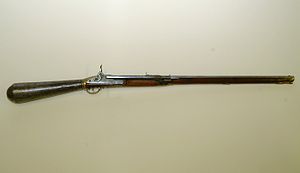This is an old revision of this page, as edited by Mike Rosoft (talk | contribs) at 08:42, 7 April 2012 (Reverted unexplained change (HG)). The present address (URL) is a permanent link to this revision, which may differ significantly from the current revision.
Revision as of 08:42, 7 April 2012 by Mike Rosoft (talk | contribs) (Reverted unexplained change (HG))(diff) ← Previous revision | Latest revision (diff) | Newer revision → (diff)| This article relies excessively on references to primary sources. Please improve this article by adding secondary or tertiary sources. Find sources: "Girardoni air rifle" – news · newspapers · books · scholar · JSTOR (May 2011) (Learn how and when to remove this message) |
| Girandoni Air Rifle | |
|---|---|
 Girandoni System Austrian Repeating Air Rifle, Circa 1795, believed to have been taken on the Lewis and Clark Expedition Girandoni System Austrian Repeating Air Rifle, Circa 1795, believed to have been taken on the Lewis and Clark Expedition | |
| Type | Air rifle |
| Place of origin | Austria |
| Specifications | |
| Caliber | .46 |
| Barrels | 1 |
| Feed system | 22 round vertical hopper |
| Sights | Iron |

The Girandoni Air Rifle was an airgun designed by Italian inventor Bartholomäus Girandoni circa 1779. The weapon was also known as the Windbüchse ("wind rifle" in German).
History and use
The Girandoni air rifle was in service with the Austrian army from 1780 to around 1815. The advantages of a high rate of fire, no smoke from propellants, and low muzzle report granted it initial acceptance, but it was eventually removed from service for several reasons. While the detachable air reservoir was capable of around 30 shots it took nearly 1500 strokes of a hand pump to fill those reservoirs. Later, a wagon-mounted pump was provided. The reservoirs themselves, made from hammered sheet iron held together with rivets and sealed by brazing, proved very difficult to manufacture using the techniques of the period and were always in short supply.
In addition, the weapon was very delicate and a small break could make it inoperable. Finally, it was very different from any other weapon of the time and any soldier using it needed to be highly trained.
The Lewis and Clark Expedition used the rifle in the demonstrations that they performed for nearly every Native American tribe they encountered on the expedition.
Design and capabilities
The rifle was 4 ft (1.2 m) long and weighed 10 lbs (4.5 kg), about the same basic size and weight as other muskets of the time. It fired a .46 caliber ball at a velocity similar to that of a modern .45 ACP and it had a tubular, gravity-fed magazine with a capacity of 20 balls. This gravity operated design was such that the rifle had to be pointed upwards in order to drop each ball into the breech block. Unlike its contemporary, muzzle-loading muskets, which required the rifleman to stand up to reload with powder and ball, the shooter could reload a ball from the magazine by holding the rifle vertically while laying on his back and operating the ball delivery mechanism. The rifleman then could roll back into position to fire, allowing the rifleman to keep a "low profile". Contemporary regulations of 1788 required that each rifleman, in addition to the rifle itself, be equipped with three compressed air reservoirs (two spare and one attached to the rifle), cleaning stick, hand pump, lead ladle, and 100 lead balls, 1 in the chamber, 21 in the magazine built into the rifle and the remaining 80 in four tin tubes. Equipment not carried attached to the rifle was held in a special leather knapsack. It was also necessary to keep the leather gaskets of the reservoir moist in order to maintain a good seal and prevent leakage.
The air reservoir was in the club-shaped butt. With a full air reservoir, the Girandoni air rifle had the capacity to shoot 30 shots at useful pressure. These balls were effective to approximately 150 yards on a full load. The power declined as the air reservoir was emptied .
Importance
The Girandoni air rifle was an important first. It was the first repeating rifle of any kind to see military service. It was one of the first uses of a tubular magazine. And, although it saw service for only 35 years, it predated and was more advanced in design and mechanical technology than the Henry rifle which arrived fifty years later.
See also
Footnotes
- Girandoni air rifle as used by Lewis and Clark. A National Firearms Museum Treasure Gun. at YouTube
- The Beeman article on Girandoni Air Rifles in the sources section and an article in the German gun magazine Visier (issue 1/2007, page 141) claim the caliber was actually .463" (11.75 mm).
- A letter detailing regulations, "Signed, Vienna, 24th January 1788"; reproduced in Baker, G; Currie, C. The Austrian Army Repeating Air Rifle 2nd Ed., 2007.
- Military writer August Haller claimed in an 1891 treatise Die österreichische Militär-Repetier-Windbüchse that the first ten shots would be effective to about 150 paces, the next ten shots up to 120-125 paces, the next ten out to 100 paces, and then the remaining air pressure in the reservoir would be too low.
Sources
- Beeman's History on Austrian Large Bore Airguns
- I Benemeriti Di Cortina D’Ampezzo
- Die Windbüchse
- Girandoni Air Rifle as used by Lewis and Clark at the National Firearms Museum